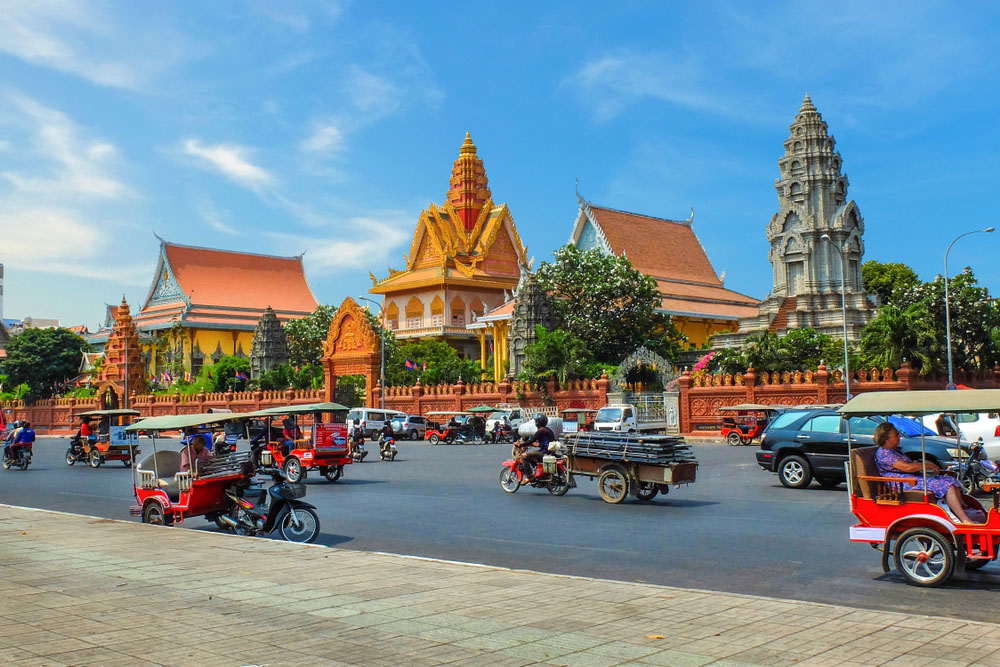It is no coincidence that the French call Phnom Penh, the capital of Cambodia, the “Pearl of Asia”. Let’s explore 8 things make Phnom Penh special.
It is no coincidence that the French call Phnom Penh, the capital of Cambodia, the “Pearl of Asia”. Located between Saigon and Bangkok, two of the largest cities in Indochina, Phnom Penh appears to be underdeveloped, but its beauty is not inferior. Let’s explore the attractions of one of the most expensive cities in Southeast Asia, which is sometimes forgotten on the journey to Indochina.
1. The most favorable geographical position of the Mekong region
Phnom Penh is located at the confluence of the Bassac, Tonlé Sap, and Mekong rivers, just like every major city in the world. After fleeing the destruction of the Thai people, the Cambodian royal came to this city and realized the advantage of the waterways and the fertility of the land. Furthermore, the Khmer cannot live far from their biggest food supplies: Tonle Sap. It takes only 7 hours to drive from Phnom Penh to Saigon and Sihanoukville, the ancient capital of Siem Reap. No Cambodian city has such a strategic position.
2. The typical tropical climate
Phnom Penh has two seasons: wet (May to September) and dry (October to March). But in every season, the capital is also pleasant enough for Europeans from the Bassac River winds blowing over the city. The sun is dry during the day but the night is as cold as the autumn weather.
3. Phnom Penh means Madame Penh hill
Legend has it that the Khmer capital was still in Angkor at the end of the 14th century. When he gathered firewood along the river, Penh found a koki floating down the river after a storm. Inside the tree, he found 4 statues of Buddha and a statue of Vishnu. This discovery is considered a divine blessing, indicating that the capital will be transferred to Phnom Penh from Angkor. To commemorate that sign, Penh raised the hill on the western bank of the Tonle Sap and built a pagoda on the north of central Phnom Penh. The temple is now known as Wat Phnom. “Phnom” in Khmer means “hill” and Penh is named after the founder.

4. Phnom Penh is the prettiest city in Indochina
The French first entered Indochina in the late 19th century and Saigon was the very first city they built based on the standards of a European city and then in Hanoi, a small Paris. Phnom Penh is the latest investment but the most radical. The French planned it from scratch not only from the center but also from the city of Phnom Penh, according to the experience they got from Saigon and Hanoi. Looking at the map of the city, you can see the sagacity in blocking and how roads are connected. Today, when you drive in this capital city, you still feel like getting lost in the small streets of Paris.
5. The peak of colonial architecture
The French are always proud of their architecture and construction until they reach Cambodia. The construction level of Khmer is not less than that of the Greek or the Roman. The French were truly persuaded and admired the classical Khmer architecture, to the extent that they skillfully applied and incorporated them into public works in Phnom Penh. The Royal Palace and the National Museum are two typical examples. In the 1950s, King Sihanouk started the “New Khmer Architecture” movement which combines the Bauhaus style, European postmodern architecture, and traditional Angkor elements.
6. Phnom Penh was more developed
Before the Khmer Rouge took power from General Lon Nol, Phnom Penh was fairly peaceful during the Indochina war. Cambodian is neutral and the country had time to develop from the 1950s to 1975. Unfortunately, the Khmer Rouge wanted to turn the country into a socialist agrarian republic and take Cambodia back to the Middle Ages. A generation was almost wiped out, the cultural heritage was diminishing.

7. The city of grieving memories
Many cities around the world were devastated by war and catastrophe. But Phnom Penh was destroyed by the Cambodians themselves. In a few months, millions of people from the cities were forced to work on communal farms in the countryside. The school was used as a torture-and-execution center until the death of political dissidents. Cambodia’s capital city is still a grieving memory with the sign in Tuol Sleng prison and memory of Cambodian survivors.
8. The city of Chinatown
Today, it is not difficult to recognize the dense presence of the Chinese in Cambodia, especially in Phnom Penh. Chen, which means Chinese, has been here since the 18th century and has become a large community in this city. The Chinese declined sharply during the Khmer Rouge until the 1990s. In recent years, the Chinese have returned and invested in the Cambodian economy. They speak Chinese and live in the Chinese way as wherever the Chinese are present.